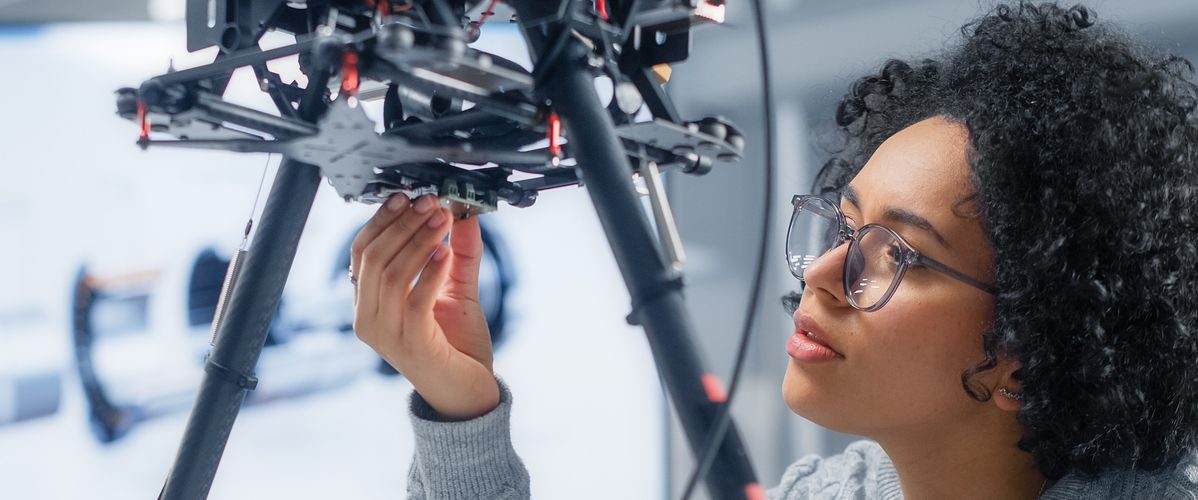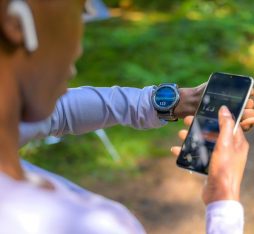• At Inria Rennes, researcher Marco Tognon is also developing autonomous drones that can cooperate to transport heavy loads. An approach that is safer than entrusting tasks of this kind to individual heavy-duty machines.
• A team at ETH Zurich has recently published an article on drones that can traverse dense vegetation and slide along obstacles which could soon be used for environmental monitoring and precision agriculture.
On paper at least, drone technology has a lot to offer the worlds of industry and building construction.
- Aerial robots could soon be used for tasks that put humans at risk, for example, transporting objects at dangerous heights for work on wind turbines and high-tension power lines. In Europe, the Italian company FlyingBasket is already marketing a cargo drone that can carry loads of up to 100 kilos. However, as researcher Marco Tognon points out: “The bigger the system, the greater the safety risks.” Tognon, who works on robotics at Inria Rennes, believes that the simultaneous deployment of several small drones is safer than using a single large one: “We are also working on 100% autonomous fleet systems that can cooperatively transport objects with each drone carrying a load of up to one kilo.”
- Drone use in the field of building construction is currently confined to visual inspection tasks that in some cases make use of computer vision or LiDAR Extending the scope of the work they do requires solutions to a number of technical challenges, and it may be some time before they can perform tasks that involve “real physical interaction in the air”. Interaction of this kind is the focus of Marco Tognon’s research, which he conducts using specially adapted machines: “The problem is that commercially available aerial robots can only stay still when they are absolutely level, and whenever they move, they need to tilt.”
The drones had to be completely redesigned, notably to allow for independent adjustment of individual propellor angles, so that we could have full control over their positioning and orientation.
Independently transporting loads and collaborating with humans
Drones can be used to take measurements at height. For example, a drone equipped with an ultrasonic transducer, which can measure material thickness from one side, can be used to check the walls of a storage tank for corrosion. However, to ensure accurate readings, the transducer must be pressed firmly against the tank walls, and the drone must remain completely immobile while each measurement is taken. This is now one of the services provided by Voliro, a Swiss startup spun off by ETH Zurich, where Marco Tognon completed his postdoctoral research. “We had to completely change the drone designs, notably to adjust the angle of individual propellors to ensure complete control over the position and orientation the drones, which is essential if you want to apply pressure on a solid surface.” The young researcher is also exploring other scenarios in which drones will be required to manipulate objects in their environment; drones could be used to adjust articulated objects like rotary valves. He believes that systems of this kind will arrive on the market within five to six years. “The goal is also to have them interact with dynamic systems including human workers. For example, they could be used to transport pipes or to carry tools to technicians working at height etc.”
New ways of dealing with obstacles
Drones can also be used to monitor the environment, as a team from ETH Zurich demonstrated in January 2023 with a drone that collects environmental DNA (eDNA) with adhsive strips. The researchers are also pursuing projects to improve the way drones interact with obstacles present in the natural environment. As they point out in an article published in Nature earlier this year, “Aerial robots perceive vegetation as obstacles to avoid. However, dense yet compliant branches, twigs, and leaves could potentially be traversed using direct physical interaction.”

Figure A: an aerial robot successfully traverses the obstacle of a hinged plate whose dynamic parameters are unknown. It continues to follow its reference path while pushing and sliding against the surface. Figure B shows the same experiment conducted with vegetation instead of the plate.
They have come up with a design, inspired by nature, for a minimalist drone capable of traversing obstacles whose elastic behaviour is unknown. Equipped with sensors on a disc-shaped shell, the drone detects physical contact with the environment before sliding across obstacles. Machines of this kind could soon be deployed in areas of dense vegetation for environmental monitoring, precision agriculture, and search and rescue operations.
 Marco Tognon
Marco Tognon










